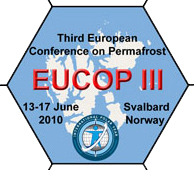 The Third European Conference on Permafrost is over. Data from many of the permafrost research projects performed during the IPY have been presented at UNIS during this conference and the conclusion is clear: the permafrost in the High Arctic is warming and Svalbard has the warmest permafrost. However, there is a lot of uncertainty regarding the speed of the warm-up and further research is necessary.
The Third European Conference on Permafrost is over. Data from many of the permafrost research projects performed during the IPY have been presented at UNIS during this conference and the conclusion is clear: the permafrost in the High Arctic is warming and Svalbard has the warmest permafrost. However, there is a lot of uncertainty regarding the speed of the warm-up and further research is necessary.
250 permafrost scientists and engineers gathered at UNIS the week of the 14th of June 2010 to share their research results from the many permafrost-related IPY projects that have been going on over the past three years. The Third European Conference on Permafrost (EUCOP III) concluded Friday afternoon.
– There has never been such a proud time in the history of permafrost research, said Professor Hans Hubberten, president of the International Permafrost Association (IPA), at the conference closing session.
– This conference is a result of taking the IPY momentum to bring scientists, engineers, different research fields, young and old people together – to go further in the future, he said.
Snapshot of the permafrost state
During the four day conference results from the several permafrost projects were presented.
– The aim of the conference was to present a synthesis of the different project results, an IPY “snapshot”, so that we for the first time can say something about the thermal state of the permafrost in the whole circumpolar area during the IPY time window, says Professor Hanne Christiansen.
Christiansen was the host for the conference, and also the PI of the Norwegian IPY project Thermal State of the Permafrost (TSP) Norway.
On the first day of the conference, Professor Vladimir Romanovsky from University of Alaska – Fairbanks presented – for the first time – an overview of the permafrost temperature in the arctic in all of the Northern hemisphere on behalf of all the TSP project teams in Alaska, Russia, Canada and the Nordic area.
Free access to the paper is provided at www.interscience.wiley.com/journal/ppp. Here is also free access to all other regional permafrost temperature papers provided.
The synthesis results presented at EUCOP III show that generally the permafrost is warming up. And the permafrost in Svalbard is the warmest this far north.
The thawing permafrost will have big consequences not only for the release of climate gases, but will also affect Arctic ecosystems and infrastructure.
The permafrost is warming up, no question about it. However, exactly the rate of the warm-up and if and when the permafrost will actually thaw in the circum-polar region, is unknown. But the observation series are still short, and it may well be that we are looking at part of a longer natural variation, Christiansen says.
– In parts of Alaska, Canada and Russia they have monitored the permafrost temperature for 20-30 years, and their long time-series thus explain the development in the thermal state of permafrost through time. However, here in Svalbard we only have observations from different landforms since the start of the IPY, except for one borehole with a 10 year record, Christiansen says.
– But the longer time series that we will collect in the future from the IPY boreholes, will allow us to be able to learn more about the Svalbard permafrost.
The road ahead
The question now is what to do with all the permafrost data.
– Although the IPY has permitted us to gather data from areas we never before had permafrost monitoring, there still are some regions where we still do not know the state of the permafrost, Christiansen says.
– We also need to organize this vast amount of data that we now have and make it available, she says.
One of the key elements in the IPY data policy and funding guidelines is that all IPY projects must provide open access to the data gathered. The TSP Norway project has gathered all its data in the database NORPERM, which is accessible via the TSP Norway website and the Geological Survey of Norway website.
– The Norwegian permafrost database is the only one so far in its kind, says Christiansen.
The way the Norwegians have chosen to provide open access to the data were positively received at the conference, and it is likely that other countries will chose a similar system when they plan their open access of their permafrost data. Also the IPA is now actively working on further developing its data policy to keep up the momentum from the large permafrost data collection campaign that the IPY provided.
The permafrost researchers will continue to monitor and analyze their data, so as to be able in the future to improve the knowledge about the changing thermal state of the permafrost.
In 2012 the Tenth International Conference on Permafrost will be held in Tyumen, Russia. More knowledge about the thermal state of the permafrost will shared there and hopefully give further clues about the future of the permafrost.